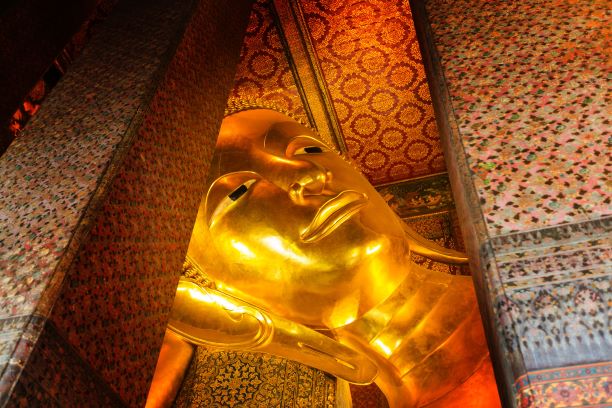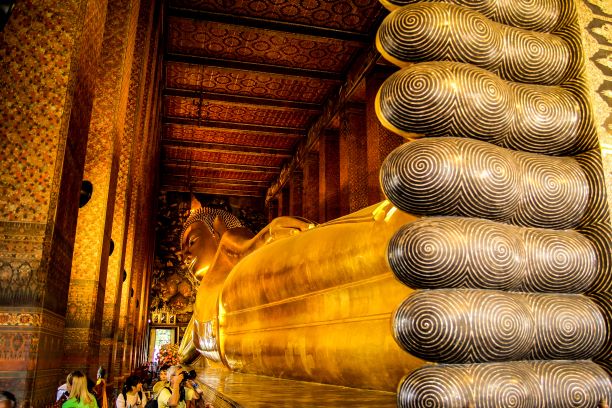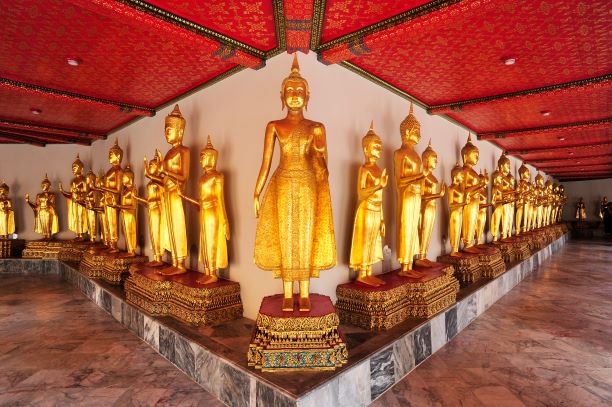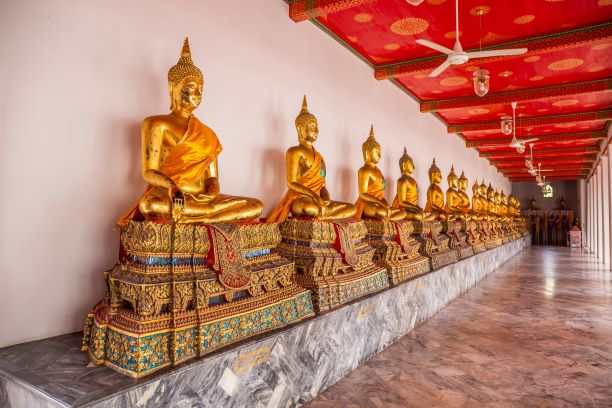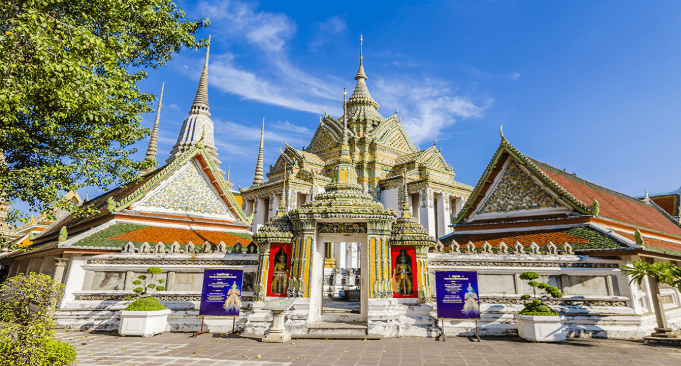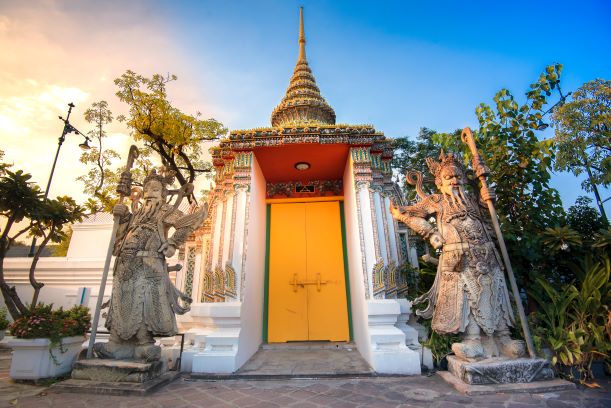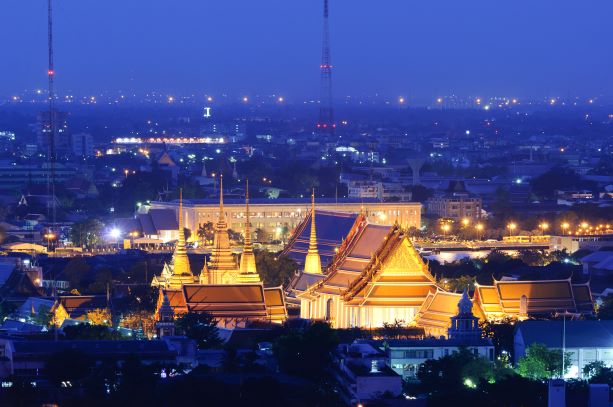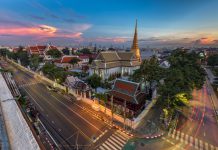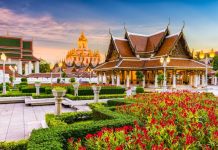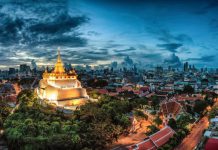
Bangkok, the capital of Thailand where is plenty of beautiful temples. And one of the famous temple in Bangkok that expands its reputation worldwide is “Wat Phra Chetuphon Vimolmangklararm Rajwaramahaviharn” or better known in general is “Wat Pho“.
So-called one of the significant landmark of Bangkok, Wat Phra Chetuphon Vimolmangklararm Rajwaramahaviharn is the highest grade of the first class royal temple, and it is also the insignia temple of King Rama 1. Besides, it is claimed as the first university of Thailand from its inscribe collections of various science. UNESCO proclaimed it as the Memory of the World in the Asia Pacific in March 2008. And UNESCO registers the inscription of the temple about 1,440 pieces as the International Memory of the World on June 16, 2011.
Wat Pho is the most massive amount of pagoda in Thailand which is 99 pagodas. And the primary one is the Four Great Chedis which are the insignia chedi of King Rama 1, Rama 2, Rama3, and Rama 4 respectively. In term of the tourism, in 2006 Wat Pho was ranked 24th most famous attractions of the World with the number of visitor in that year is 8,155,000.
Background of the Temple
The temple was built since Ayutthaya era, nonetheless with no any proof of the construction. It is initially called “Wat Photharam” or “Wat Pho” and was upgraded to be a royal monastery in Thonburi era. Then, during the reign of King Rama 1 in Rattanakosin era, he ordered to restore the temple including new construct of Ubosot, Phra Rabieng (veranda), and Phra Vihara (royal chapel). The monastery complex was completed in 1801 and named “Wat Phra Chetuphon Vimolmangklawas” being the temple in honour of King Rama 1.
Since then, the temple was primarily renovated in the period of King Rama 3, and he graciously commanded to engrave many textbooks on the marble and install them in the pavilions in the temple. Later, the king Mongkut bestowed the suffix in verse is Wat Phra Chetuphon Vimolmangklararm Rajwaramahaviharn which has been the name of the temple until now. The temple used to serve the coronation ceremony of King Narodom of Cambodia de jure before the celebration de facto in Cambodia after that.
The kings of Chakri dynasty consider Wat Phra Chetuphon Vimolmangklararm Rajwaramahaviharn (Wat Pho) is the significant royal temple and is the royal tradition to renovate the temple in every reign. Furthermore, the temple is so-called the first university of Siam because there are collections of various sciences including history, literature, and medicine.
The Important Construction in Wat Pho
The temple is a house of significant amount of religious collection particularly Buddha image and pagoda. The complex contains a lot of structures which categorised into 2 groups are;
1. The Old Complex
It is the area in the west of the temple nearby the river Chao Phraya. It is the location of Vihara of the Reclining Buddha Image, sermon hall (former Ubosot), Phra Mondop, and the Four Great Chedis.
1.1 Viharn of the Reclining Buddha Image
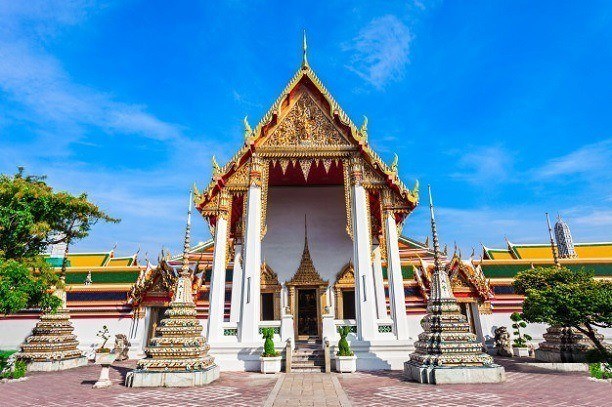
Viaharn or the chapel was constructed by order of King Rama 3 to extend the monastery complex to the north. The construction started with the making of the Reclining Buddha Image then built the chapel to cover the statue. The wall of vihara is the mural painting of Mahawongsa Chronicle and the wall in between the window is mural of the 13 specialist Buddhist nuns, 10 specialist Buddhist men, and 10 specialist Buddhist women.
The Giant Reclining Buddha which is the primary image inside the vihara is a stucco Buddha with gild. The statue is one of the most prominent reclining Buddha images in Thailand with specific characters which are the left and right foot overlapped equally. The feet are the auspicious pattern of 108 prosperous which a combination of the belief derived from India and China. And in the middle is a wheel according to Maha Purisa Lakana (marks of the Great Man).
1.2 The Four Great Chedis
They are large pagodas situate next the Ubosot around by the defensive wall. The architectural style of the archway is Chinese-Thai contemporary with a couple of agalmatolite on each side. The pagoda is bell-shaped with square-base and furnished by China.
Initially, King Rama 1 invited the remaining Phra Sri Sanphetdayan from Wat Phra Sri Sanphet, Ayutthaya to rebuild the new one. However, the consoler informed that it would be unfortunate for the country to do that hence the king ordered to build a new large pagoda in bell-shape with the square base to cover the remains. The pagoda named as “Phra Maha Chedi Sri Sanphetdayan”. The chedi decorated by the jade-colour of China located as a centre of the Four Great Chedis and considered as the insignia pagoda of King Rama 1.
Later, King Rama 3 initiated a plan to renovate the temple and build pagoda on both sides of the Phra Maha Chedi Sri Sanphetdayan. Then they were three of pagodas orderly stand from the north through the south. All three pagodas are mostly alike but the colour that the one in the north of Phra Maha Chedi Sri Sanphetdayan is in white named Phra Maha Chedi Dilok Thammakorn Kanithan” that King Rama 3 dedicated to King Rama 2, his father and considered as the insignia pagoda of King Rama 2. And the pagoda in the south is in yellow called “Phra Maha Chedi Muneebat Borikhan” that was built to dedicate for Buddhist worship and considered as the symbol pagoda of King Rama 3.
And after the coronation of King Mongkut (Rama 4), he gave a command to take a pattern of Phra Chedi Sri Suriyothai from Wat Suan Luang Sob Sawan, Ayutthaya to construct the new pagoda for Buddhist worship. This pagoda is different from the previous ones that it is archway to get into the pagoda, and the chedi is furnished by dark blue china and called “Phra Maha Chedi Song Phra Sri Suriyothai”. The chedi is considered as the symbolic pagoda of King Rama 4. However, there is no any new construction of pagoda in Wat Pho since then according to the royal remark of King Mongkut.
1.3 Sala Karn Parien
Former the Ubosot of Wat Photharam since Ayutthaya period. However, once the new ubosot was found, then the hall was disrated to a sermon hall. There is the “Phra Buddha Sasada” as a principal image inside the building.
2. Ubosot Complex
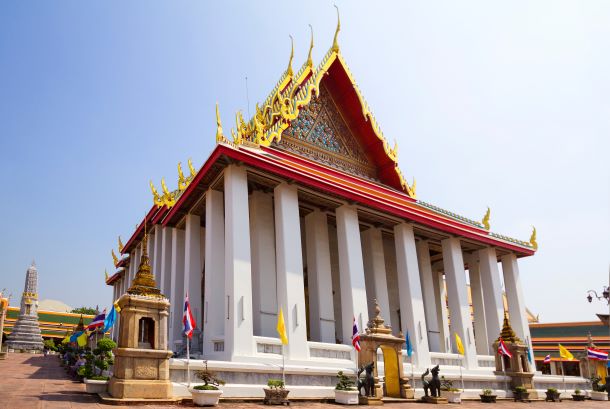
It is a new complex outside the region of old Wat Pho which constructed according to the belief of Three World. The Ubosot performs as Mount Meru, and the Four Directions Viharn are the main four continents.
2.1 Phra Ubosot
It is a house to enshrine Phra Buddha Dheva Patimakorn, a Buddha image in the attitude of meditation that King Rama 1 invited from Wat Sala Si Na from his firm purpose to establish Bangkok being a permanent capital of Siam.
2.2 Phra Viharn Thit (The Four Directions Viharn)
The chapels house the significant Buddha statues by divided to locate at the front veranda and the rear gallery. The front gallery faces to other directions and the rear veranda faces to the Phra Ubosot. The chapels allocated to four directions which are;
- The Chapel of the East (Phra Lokanat)
At the front veranda enshrines Phra Buddha Maravichai, a Buddha image in the attitude of subduing Mara. The statue was invited from Wat Khao In, Sukhothai. The rear veranda houses Phra Buddha Lokanat Sasadachan which was created in Ayutthaya era. The image was invited from Viharn Phra Trilokanat within Wat Phra Sri Sanphet.
- The Chapel of the West (Naga Prok)
At the front veranda enshrines Phra Buddha Chinnasri Muneenat, a Buddha image in the attitude of spreading Naga which former house at Sukhothai. The statue was invited together with Phra Buddha Chinnarat.
- The Chapel of the North (Pa Lelai)
Phra Buddha Pa Lilai enshrines at the front veranda of the viharn. The statue is Buddha image with an elephant offering a bowl of fruit and an approaching monkey offering a honeycomb which was cast by order of King Rama 1 on the occasion of the establishment of the temple.
- The Chapel of the South (Panjavakkhi)
Phra Buddha Chinnarat enshrines at the front veranda of the chapel. The image is Buddha statue in the attitude of the first sermon which is invited from Sukhothai.
3. The Monastery of Chedi
Wat Pho is known as the most amount of pagoda in Thailand that divided into 4 categories – the Four Great Chedis which are enshrined within the old complex. While ones locate within the Ubosot area are 71 of Chedi Rai, 20 of Five Chedis on a Single Base, and 4 of Prang or the Grand Stupa which is in total 99 chedis.
The pagodas locate in the area of Phra Ubosot are;
3.1 Chedi Rai
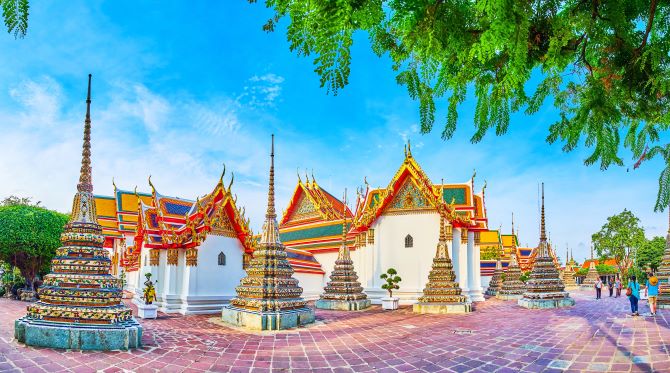
Group of 71 chedis stand around the outside veranda that was constructed in the reign of King Rama 3. Formerly, the pagoda was planned to bury the ashes of the royal family. The pagoda furnished by colour china and jade-like stone. The pagoda is smaller from other pagodas locating in the temple. Phra Chedi Rai at Wat Pho is classified as the most beautiful bell-shaped with the square base pagoda in the Rattanakosin era.
3.2 Five Chedis on a Single Base

The chedis constructed in the reign of King Rama 1. The characteristic of the pagoda is five pagodas on a single base; nevertheless, the one in the middle is bigger than the others that located in the four corners. The total number of the group of chedis is 20, and there is the Buddha relic housed inside each pagoda.
3.3 Phra Prang
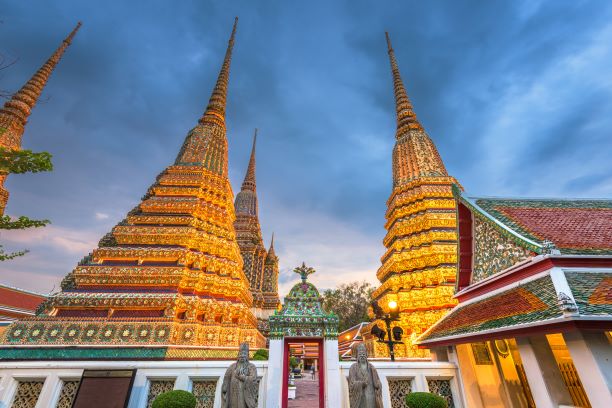
There are four towers of Prang chedi located in the four corners of the Ubosot. Each chedi is guarded by the statues of Thao Jatulokabarn (the four keepers of the world) made from tin and cover with lacquer work in all four directions. And there is the giant statue to carry the top of the pagoda. Each Prang has the different name by following
The North Eastern Prang called “Phra Buddha Mangalagayapanthana Mahasatup.”
The South Eastern Prang called “Phra Buddha Dhammachakkapavattanapatuga Mahasatup.”
The South Western Prang called “Phra Buddha Vinayapitakasujikhara Mahasatup.”
The North Western Prang called “Phra Buddha Abhidhamtharawasi Parikkhara Mahasatup.”
Other exciting figures in Wat Pho
Apart from buildings, chapels, and pagodas, there are more appealing things within the monastery such as;
1. Contorting Hermit Statue
The record by Prince Damrong Rajanubhab regards to the contorting hermit statue at Wat Pho noted that;
“When King Rama 1 gave the order to restore Wat Photharam, he collected the knowledge of traditional medicine and sciences of Ayutthaya including the figures of contorting hermit. However, there’s no any record of the amount of the figure. Then, in the reign of King Rama 3 that commanded to cast 80 figures of contorting hermit from tin and corrugated iron instead of clay that is easier to broken. And there was the description of all figures. Unfortunately, because the displacement of the statues and some were stolen, therefore there are only 24 contorting hermit figures exist at the temple, presently.”
2. Giant of Wat Pho
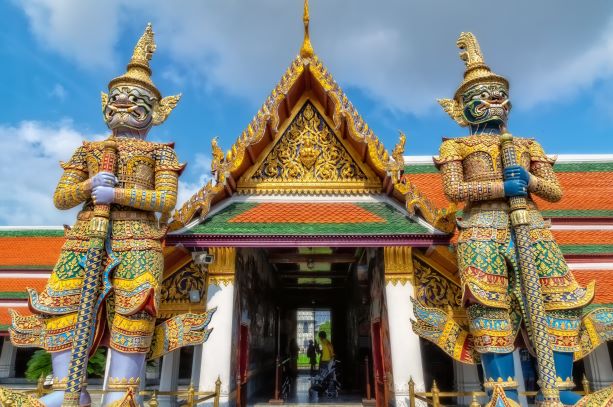
The giant of Wat Pho is another renowned structure of the temple. They located at the archway of Mondop. They are in red and green with the appearance similar to the giants in the Ramayana epic. However, there are many people misunderstand that the agalmatolite or “Lanthan” the gatekeeper standing in front of the entrance of the temple is the Giant of Wat Pho. Additionally, there is a legend related to the giants of Wat Pho and Wat Chaeng (Wat Arun) which created Tha Tien in the present.
The First University of Siam
Wat Phra Chetuphon Vimolmangklararm Rajwaramahaviharn or Wat Pho is so-called the first university of Thailand. According to the dominant restoration in the period of King Rama 3, he graciously collected various arts and sciences and inscribed onto the stone, including to cast the statues of contorting hermit to locate within the monastery complex. That knowledge was divided into 8 categories which are
- History of Wat Phra Chetuphon establishment
- Traditional medicines and prescription
- Sanitation
- Tradition
- Thai Literature
- Proverb
- The dependency of the early Rattanakosin
- Buddhism
Those categories compare to the faculties in the university nowadays are Faculty of History, Faculty of Fine and Applied Arts, Faculty of Liberal Arts, and Faculty of Medicine (unofficially).
Information of Wat Pho
The temple resides on Sanamchai and Maharaj Road nearby the Grand Palace in Bangkok.
It opens daily between 8.00am – 5.00pm.

